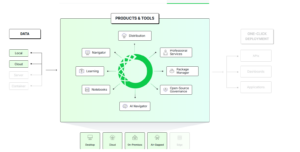
Anaconda Simplifies Open Source Python Stack with AI Platform Launch

(KateV28/Shutterstock)
Anaconda today unveiled the AI Platform, a new flagship offering that provides a standardized user experience that should be easier to administer. The company also tripled the number of Python libraries in the stack, and launched a new AI copilot for its command line interface.
Anaconda is well-known in the big data industry for doing the hard, unforgiving work of making sure that thousands of mostly Python (with some R) libraries work well together. Instead of forcing data scientists to figure out on their own how to make various versions of Scikit-learn, Matplotlib, and Dask work well, for instance, Anaconda engineers built a standardized distribution with 4,000 public and private repositories that provided some assurances that things won’t break when deployed on Windows, Linux, or MacOS.
In addition to the core Anaconda Distribution, which is used by 50 million data scientists, analysts, and developers around the world, the Austin, Texas company provided a range of other free and open source products that addressed specific needs, such as Cloud Suite (for cloud-based data science), Navigator (for desktop-based work), Notebooks (Anaconda Toolbox (for Excel-based data science), and AI Navigator (for generative AI on the desktop), as well as administrative tools like Package Security Manager.
The goal with Anaconda AI Platform is to unify the experience across all of these products while making it easier to get started, said Laura Sellers, Anaconda chief product and technology information officer.
“There were so many different offerings, if you will, and different capabilities within there, it wasn’t packaged up well to make it easy to seamlessly experience all of it across the platform,” Sellers says. “We have a variety of personas. From our practitioner experience, a lot of that remains the same…But this is really about the admins etc. inside the organization having a unified experience and pane of glass and view into open source inside the organization.”
The new AI Platform will also boost governance and security across the Anaconda tools. According to Sellers, it will enable administrators to better define policies that control what packages various users can work with, as well as fix security problems when they arise.
For instance, if one of the packages has a CVE, or a registered security vulnerability, associated with it, then current users of the package will be alerted to the event, and controls will activate to disable the package through the Anaconda tools, Sellers says.
“We really are the only unified AI platform for open source that combines trusted distribution, simplified workflows, real time insights, as well as governance controls that are all required to really boost practitioner productivity and save organizations time, money, and risk,” Sellers tells BigDATAwire in an interview.
The company is also dramatically increasing the number of packages that it includes in its distribution. The current Anaconda Distribution has about 4,000 libraries today. As part of the launch Anaconda is introducing Conda Forge as packages that will be part of our community repository, Sellers says, which will boost the total number of available Python (with some R) libraries to almost 12,000 packages, she says.
Data scientists who prefer to work in a command line environment will also benefit from the introduction of the new Anaconda Assistant for CLI. That AI copilot capability has been available only for users working in graphical environments.
 As part of the package unification, Anaconda will take the opportunity to clarify some of its licensing policies. While the company is committed to providing free tools for research organizations and small businesses, the company has taken a bit of heat for actually enforcing its license with commercial outfits and larger organizations.
As part of the package unification, Anaconda will take the opportunity to clarify some of its licensing policies. While the company is committed to providing free tools for research organizations and small businesses, the company has taken a bit of heat for actually enforcing its license with commercial outfits and larger organizations.
“We really are just making sure we have more clarity and consistency around what is a free user versus what is a paid user, and also giving us enhanced terms of service, if you will, for academic research, non-profit support,” she says. “That should make it a lot easier for people to understand what is free versus what is paid for.”
According to Anaconda’s pricing page, use of the Anaconda tools at an organization with more than 200 employees requires a business or enterprise license. Business licenses starts at $50 per user per month, while enterprise licenses are privately negotiated.
Sellers, who was hired in February, confirms that she was brought in to help with the Anaconda product unification exercise. She previously had executive stints at Alteryx and Collibra. In addition to being the company’s chief product and technology officer, Sellers holds the title co-president, a position she shares with Jane Kim, who is also the chief commercial officer. The company does not currently have a listed CEO following the departure of Barry Libert at some point over the past 12 months. Anaconda Co-Founder and former CEO Peter Wang continues to hold the title of chief AI and innovation officer.
Related Items:
Anaconda Hooks Python, R Libraries Into Snowflake Data Science Notebook
Anaconda Rejiggers Approach to Boost Growth Under New CEO
Anaconda’s Commercial Fee Is Paying Off, CEO Says



























